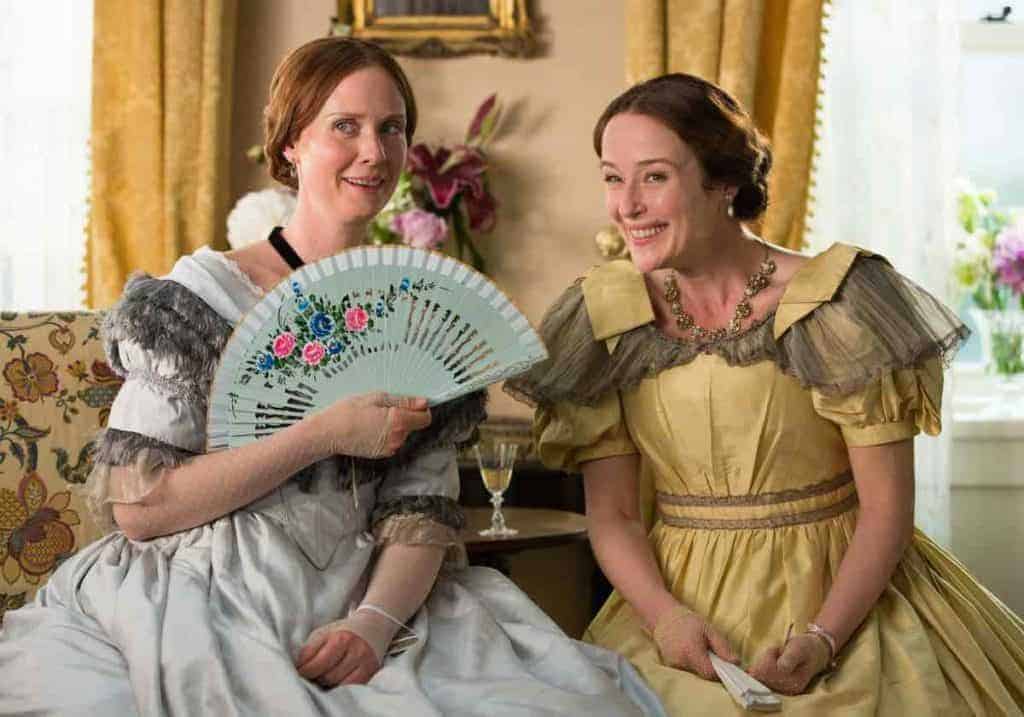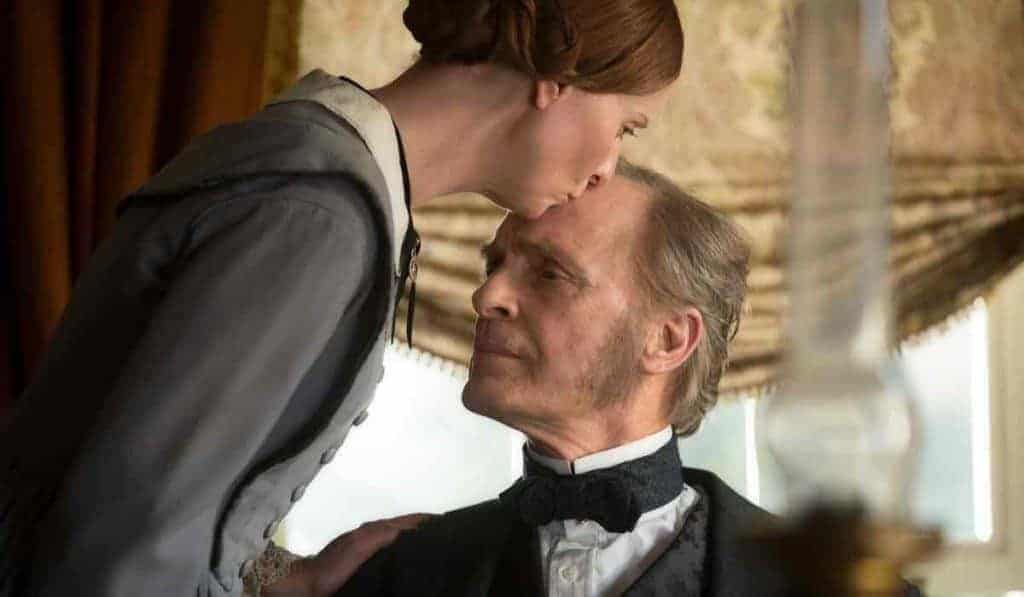In A Quiet Passion, Terence Davies’ new biopic, Emily Dickinson, the famously reclusive poet, comes to life as an understated renegade, who deserts gendered orthodoxies to pursue her art. This is the first article in our Special Issue on A Quiet Passion.

Emily Dickinson never learned to stomach convention. From 1831 to 1884, at a time when women were encouraged to become only wives and mothers, she pursued the life of an artist. Except for a brief stint at Mount Holyoke Female Seminary, she lived her whole life in her family’s home in Amherst, MA, where she wrote nearly 1,800 poems, only seven of which were published during her lifetime. Today she is famous for how she lived and what she wrote: in both respects, she broke the rules.
[clickToTweet tweet=”Review: A QUIET PASSION immerses us in the drama of Emily Dickinson’s famously ‘quiet’ life. ” quote=”A Quiet Passion immerses us in the drama of Emily’s famously ‘quiet’ life. “]
Terence Davies’ exquisite biopic A Quiet Passion immerses us in the drama of Emily’s famously “quiet” life. Cynthia Nixon, who stars as the poet, inhabits every paradox of Emily’s personality. She is soft-spoken yet defiant, reclusive yet loving, skeptical yet spiritual. Always, she is a force to be reckoned with, challenging dogma and prioritizing her art. In this way, Davies’ film recalls poet Adrienne Rich’s 1976 essay, “Vesuvius at Home,” which traces both Emily’s allure and the injustices dealt her by scholars. “Given her vocation,” Rich writes, “[Emily] was neither eccentric nor quaint; she was determined to survive, to use her powers, to practice necessary economies.”
Davies recasts the poet’s life as a series of confrontations, in which Emily rebels rather than retreats. The film opens with footage of Emily breaking rank. At Mount Holyoke, a group of students are lined up like dolls on a shelf. The school uniform — a low bun, black dress, and serious face — has the effect of masking individuality, so we don’t know which of these women is the film’s subject. When the class is asked about their religious beliefs, however, the young Emily (Emma Bell) distinguishes herself. “I wish I could feel as others do,” she announces, “but it is not possible.” What her independence of sentiment makes possible, of course, is poetry.
[clickToTweet tweet=”Davies recasts the poet’s life as a series of confrontations…Emily rebels rather than retreats.” quote=”Davies recasts the poet’s life as a series of confrontations, in which Emily rebels rather than retreats.”]

At home, Emily balks under another kind of authoritarianism. Her father, Edward Dickinson (Keith Carradine), a distinguished lawyer and politician, sets the rules she lives by. An early scene at the opera establishes his views on gender. As a woman delivers a solo, the camera focuses on the Dickinson family in the audience. For Emily, who sits with hands clasped and eyes wide, the music is revelatory, but Edward disapproves. “I do not like to see a woman upon the stage,” he snorts. It’s easy to hear in this conversation a reference to Emily’s poetry: she is permitted to make art, too, as long as she doesn’t seek credit or the spotlight.
To make Emily’s “quiet passion” more audible, Davies gives ample screen time to Vryling Buffam, Emily’s more audacious friend. When Emily and her sister, Vinnie (Jennifer Ehle), invite Vryling to join them at church, Vryling retorts, “Don’t enjoy your praying too much. It might become habit-forming.” Spending time with Vryling inspires Emily to be more confrontational. One day, she refuses to kneel before a pastor, and the next morning she slams a plate on the kitchen table — loudly. There is something both impressive and pitiful about this act of defiance, in which objects of domesticity turn, momentarily, into weapons. Emily uses the tools at her disposal to make noise.
[clickToTweet tweet=”In A QUIET PASSION, Emily uses the tools at her disposal to make noise.” quote=”Emily uses the tools at her disposal to make noise.”]
Sitting at her desk, quill in hand, Emily finds her voice. In one such scene, her father enters, and she informs him she will no longer join him at church. “No, father,” she says clearly, “God knows what is in my heart.” Here, it is Edward who surrenders and retreats. He closes the door and leaves Emily to her work—stitching together fascicles, bounded collections of her verse. Her quill pierces the silence, and we listen to her scribbling.
[clickToTweet tweet=”‘Her quill pierces the silence, and we listen to her scribbling.’ – Gillie Collins on A QUIET PASSION” quote=”Her quill pierces the silence, and we listen to her scribbling.”]
After her father’s passing, Emily becomes increasingly reclusive. Her retreat from his deathbed is literal: slowly, whimpering, Emily backs away into the hallway. When the funeral procession leaves the house, the camera floats upward to Emily’s bedroom window. She opens the curtains then recoils. This sequence dramatizes what becomes a trend, as Emily chooses, more and more, to observe rather than participate. She lashes out at her family and rarely ventures downstairs to greet guests.
It’s never clear whether this seclusion is a matter of fear or proto-feminist principle. In “Vesuvius at Home”, Rich argues that the poet’s decision not to marry was strategic: “What, in fact, did she allow to ‘put the Belt around her Life’ — what did wholly occupy her mature years and possess her? For ‘Whom’ did she decline the invitations of other lives? The writing of poetry.” By this account, Emily was anything but a pathological hermit: she was a radical, committed to art above all else.
[clickToTweet tweet=”‘It’s never clear whether Emily’s seclusion is a matter of fear or proto-feminist principle.'” quote=”It’s never clear whether this seclusion is a matter of fear or proto-feminist principle.”]
Davies honours Emily’s oeuvre by using a handful of her poems as voice-overs. Nixon’s reading of “If you were coming in the fall” is dynamic — at first, fast-paced and exuberant, then slow and pensive. Davies doesn’t aim to close the gap between art and life or use Emily’s biography to “solve” her poems. Her motivations and literary influences remain mysterious. What is clear, however, is Dickinson’s dedication to her craft. She keeps writing, even when her work is belittled and rejected for breaking rules of meter and rhyme.
Like its subject, A Quiet Passion defies conventions. Though the movie follows a linear narrative and focuses on Emily’s quotidian life, there are moments when it interrupts itself. During one such interlude, Davies provides archival footage of and statistics on Civil War battles, while Nixon reads some of Emily’s most moving poems. Here, her words soar above the sounds of war. Cannons pale in comparison: “To fight aloud, is very brave – / But gallanter, I know / Who charge within the bosom / The Calvalry of Wo.”
[clickToTweet tweet=”A QUIET PASSION presents Emily as both possessed and emancipated by her art.” quote=”A Quiet Passion presents Emily as both possessed and emancipated by her art.”]
A Quiet Passion presents Emily as both possessed and emancipated by her art, especially toward the end of her life. All other priorities dissipate, but frequent illness interrupts her process. During her death scene, she is sitting at her desk, in the midst of writing when a seizure strikes. She finds her way to the bed and tucks herself in. Behind her, the desk is bathed in light. While her body shakes and rattles, there is a sense, perversely, of peace. Through her poetry, she rebels — this time from death.
[clickToTweet tweet=”‘Dickinson might be famous for living as a ghost but she comes to life as infinitely complicated.'” quote=”Emily Dickinson might be famous for living as a ghost…but she comes to life in A Quiet Passion as infinitely complicated. “]
Emily Dickinson might be famous for living as a ghost — dressed in white, shut in her bedroom — but she comes to life in A Quiet Passion as infinitely complicated. As Davies told the Independent in 2016, “[the film] is not a documentary. It is going to be a subjective fictional idea of this woman. I can’t have everything in, I can’t. There will be certain things I will elide.” If an artist’s job is, in fact, to “Tell all the truth but tell it slant,” this film triumphs. Its angle does more than delight.
Read the rest of our Special Issue on A Quiet Passion here.

